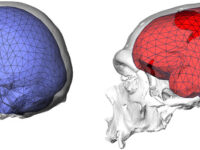On October 4, 2021, David Julius and Ardem Pataoutian won the Nobel Prize in Medicine for discovering how we can distinguish pain from spicy food and warmth from a hug. Their discovery marks a major leap in our understanding of how the human body converts sensations from the environment to electrical signals that the brain can understand. Patrik Ernfors, one of the members in the Nobel Prize Committee, remarked that their research has “unlocked one of the secrets of nature, by explaining the molecular basis for sensing temperature and mechanical force.” From feeling the crisp wind against our face when we first walk outside to the wet sand between our toes on the beach, our ability to sense our ever-changing environment is one of the most quintessential facets of life and has remained a mystery to many scientists over the years. In fact, in the 17th century, René Descartes thought that humans could sense the outside environment through long threads that connected the different parts of the body to the brain. The Nobel Prize research thus represents a significant breakthrough in understanding the intricacies of the nervous system and its relation to physical stimuli.
From feeling the crisp wind against our face when we first walk outside to the wet sand between our toes on the beach, our ability to sense our ever-changing environment is one of the most quintessential facets of life and has remained a mystery to many scientists over the years.
To discover how the body feels a burning sensation from spicy food, Julius’ experiment used capsaicin, a compound found in many peppers that is responsible for heat. Julius and his team at the University of California, San Francisco started by creating a cDNA library containing millions of genes that are expressed in sensory neurons associated with pain or touch. The search for the specific gene that causes cells to react to capsaicin was an arduous task, as his team meticulously expressed, or turned on, each gene in cells that were unresponsive to capsaicin and then observed which cells became responsive due to that gene expression. They ultimately identified a gene that codes for a TRPV1, a receptor on the surface of cell membranes that acts as an ion channel. Capsaicin reacts with TRPV1 to cause ion channels to open and calcium ions to flood into the cell, sending an electrical signal to the brain that produces pain. A few years following the breakthrough discovery of TRPV1, Julius and Pataoutian independently found the gene TRPM8, which works similarly to TRPV1 but reacts to menthol, a chemical compound that produces a cool and minty taste. The discovery of both receptor proteins, TRPV1 and TRPM8, explains how we feel hot, cold, and their sometimes painful effects.
As for the “touching” aspect of the research, Pataoutian and his team at the Scripps Research Institute identified how the body converts mechanical stimuli or touch to neural signals. The team identified 72 possible genes that code for receptors associated with ion channels on the cell membrane. Through manipulation of a cell line, a culture where one cell that releases an electrical signal when poked is propagated continuously, Pataoutian’s team underwent the painstaking task of silencing each of the 72 identified genes to determine which was responsible for producing an electrical signal. Finally, one silenced gene caused cells to be unresponsive to any poking. The gene codes for an undiscovered ion channel that was then named “Piezo1” after the Greek word for pressure. Pataoutian also found another touch protein receptor, now called “Piezo2,” and both these receptors are important for maintaining many bodily processes like blood pressure and breathing.
The team identified 72 possible genes that code for receptors associated with ion channels on the cell membrane.
Julius and Pataoutian’s breakthrough discovery has launched a new field of research involving the development of pain drugs that specifically target cell protein receptors similar to the ones they found. For example, another receptor called TRPC5, identified by other researchers, was found to cause pain when cold touches a damaged tooth. Developing a drug that inhibits TRPC5 could potentially be a powerful treatment technique, and this concept can be extended to a multitude of different receptors. Unfortunately, inhibiting a receptor to treat a specific part of the body is not as easy as it seems, as the same receptor could be needed elsewhere. Thus, important research on these pain-relieving drugs is still being conducted today, and some researchers are close to inhibiting specific receptors. Any new treatments created will all be thanks to the work of Julius and Pataoutian.
Nature (2014). DOI: https://doi.org/10.1038/nature13980
Nature (1997). DOI: https://doi.org/10.1038/d41586-021-01283-6
Science (2002). DOI: 10.1126/article.25128
Science (2018). DOI: 10.1126/science.aau6324
Science (2021). DOI: 10.1126/sciadv.abf5567






